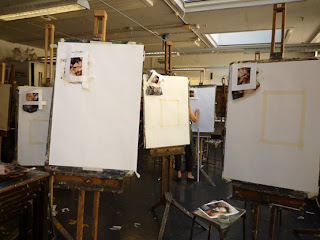 Get set -
Get set -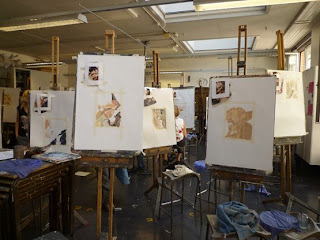 Interesting exercise, this - do try it at home. Take a large colour picture of a face from a magazine, crumple it and arrange it into an interesting non-flat shape, and use a viewfinder (two L-shaped bits of paper) to find an interesting composition in your now-3D object. Paint it just as you see it - crumples, ridges, shadows and all - paying attention to the local colour. The dark areas will grab the eye, but it's helpful to work from dark to light rather than light to dark.
Interesting exercise, this - do try it at home. Take a large colour picture of a face from a magazine, crumple it and arrange it into an interesting non-flat shape, and use a viewfinder (two L-shaped bits of paper) to find an interesting composition in your now-3D object. Paint it just as you see it - crumples, ridges, shadows and all - paying attention to the local colour. The dark areas will grab the eye, but it's helpful to work from dark to light rather than light to dark.By lunchtime I'd got this far -
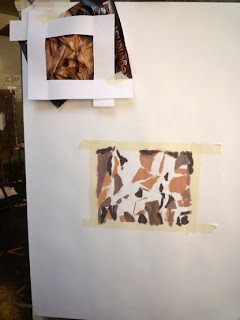 During the afternoon there were one or two moments of frustration. Hmm, maybe more than one or two...
During the afternoon there were one or two moments of frustration. Hmm, maybe more than one or two...
 During the afternoon there were one or two moments of frustration. Hmm, maybe more than one or two...
During the afternoon there were one or two moments of frustration. Hmm, maybe more than one or two...But at the end of the day everyone had come up with interesting results. Here's a sample -
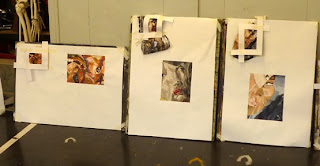

In my eyes, my "finished" piece leaves a lot to be desired. Despite adding pencil to the work (I liked that effect), and then trying to paint over the pencil, and using washes, and adding darker areas, I never did get something coherent. (Also, I'm not terribly comfortable with doing violent stuff to pictures of people - even though "it's only a picture".)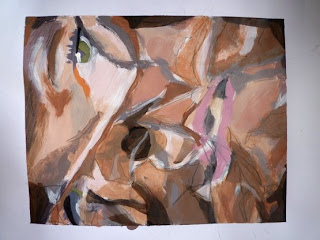 But mixing up the flesh tones was a revelation. Basically you start by adding one colour to white - and whether it's blue, red or yellow makes quite a difference in where you go from there. Also, whether the red is crimson or scarlet makes a big difference - with one you get grey and with the other you get brown.
But mixing up the flesh tones was a revelation. Basically you start by adding one colour to white - and whether it's blue, red or yellow makes quite a difference in where you go from there. Also, whether the red is crimson or scarlet makes a big difference - with one you get grey and with the other you get brown.
 But mixing up the flesh tones was a revelation. Basically you start by adding one colour to white - and whether it's blue, red or yellow makes quite a difference in where you go from there. Also, whether the red is crimson or scarlet makes a big difference - with one you get grey and with the other you get brown.
But mixing up the flesh tones was a revelation. Basically you start by adding one colour to white - and whether it's blue, red or yellow makes quite a difference in where you go from there. Also, whether the red is crimson or scarlet makes a big difference - with one you get grey and with the other you get brown.
2 comments:
My hubby & I just watched one of those painting shows on PBS where the guy started with gesso (that was his white) added a colour, then as he continued to paint he added a colour to that. We both looked at each other in awe....now to remember to use that when we do some painting...
LOVE reading your blog!!!
Now that's an interesting exercise. I will definitely try this...maybe not today, but sometime soon. Thanks!
Post a Comment